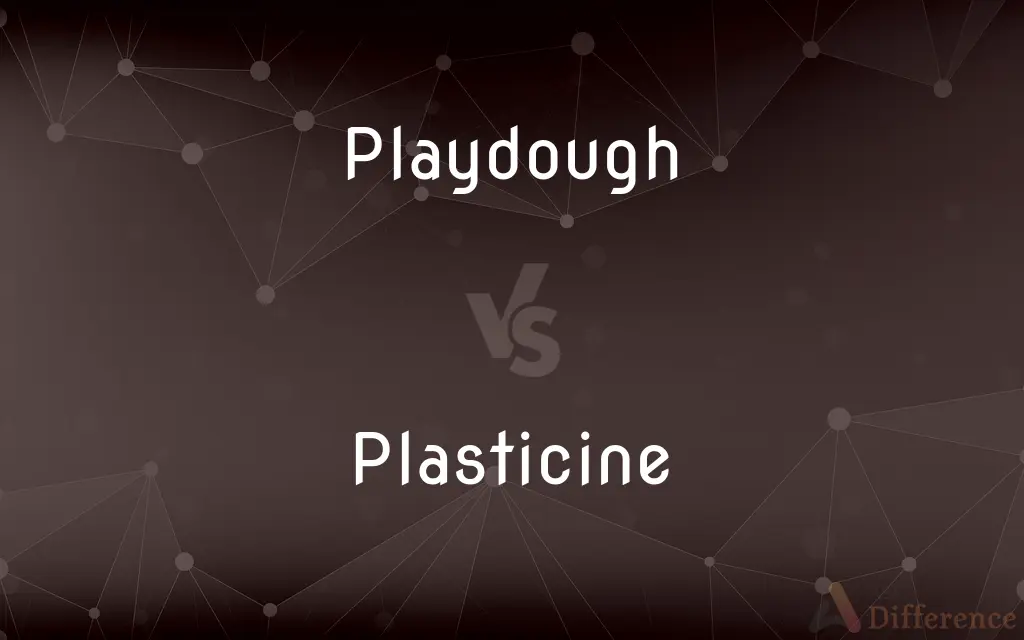Playdough vs. Plasticine — What's the Difference?
By Tayyaba Rehman & Fiza Rafique — Updated on March 29, 2024
Playdough is a soft, pliable modeling compound used primarily for children's crafts and play, known for its easy-to-use and non-toxic properties. Plasticine, on the other hand, is a more durable, non-drying modeling material used for art and animation.

Difference Between Playdough and Plasticine
Table of Contents
ADVERTISEMENT
Key Differences
Playdough is celebrated for its soft texture and malleability, making it ideal for young children's creative projects. It's designed to be non-toxic, safe if ingested, and comes in vibrant colors to stimulate sensory play. Whereas Plasticine boasts a firmer consistency that retains its shape better, suitable for detailed modeling work in art and stop-motion animation. It's preferred by professionals and hobbyists for its versatility and the ability to be reused without drying out.
The composition of Playdough includes flour, water, salt, boric acid, and mineral oil, which contribute to its softness and temporary nature. This formula allows for easy manipulation but limits its lifespan, as it can dry out and crumble. On the other hand, Plasticine is made from calcium salts, petroleum jelly, and aliphatic acids, giving it a smoother, non-drying quality that makes it enduring for repeated use and long-term projects.
Playdough's primary use is in educational settings and playtime, focusing on sensory development and fine motor skills among young children. Its temporary nature encourages exploration and creativity without concern for permanence. Plasticine, whereas, is utilized in both educational and professional settings, including art classes and film production, particularly in stop-motion animation, where its stability and detail retention are crucial.
The environmental impact of both materials also varies. Playdough, being mainly composed of natural ingredients, is more biodegradable and considered environmentally friendly. Plasticine, however, due to its petroleum-based components, poses more challenges in disposal and is less eco-friendly.
In terms of availability and cost, Playdough is widely available in stores and can also be homemade, making it a cost-effective option for parents and educators. Plasticine, on the other hand, might come with a slightly higher price tag due to its specialized use and longer lifespan, but it offers value for those needing a durable, reusable modeling material.
ADVERTISEMENT
Comparison Chart
Composition
Flour, water, salt, boric acid, mineral oil
Calcium salts, petroleum jelly, aliphatic acids
Texture and Durability
Soft, dries out
Firm, non-drying
Primary Use
Children's play and education
Art, animation, modeling
Environmental Impact
More biodegradable
Less eco-friendly
Cost and Availability
Widely available, can be homemade
Slightly higher price, specialized stores
Compare with Definitions
Playdough
Non-toxic, pliable dough used in preschool for creative play.
The kids spent the afternoon crafting playdough animals.
Plasticine
A non-drying, malleable modeling material used for detailed crafts and animations.
The animator used plasticine to create detailed characters for the film.
Playdough
A soft, colorful craft material for children, made from flour and water.
She molded a blue playdough into a star.
Plasticine
Suitable for professional art and modeling, capable of fine details.
Artists prefer plasticine for its precision in sculpting.
Playdough
Easily dries and crumbles, emphasizing temporary creations.
After a week, the playdough sculpture had dried out.
Plasticine
Composed of petroleum jelly and calcium salts, offering a smooth texture.
The plasticine felt smooth and retained its shape well.
Playdough
Can be made at home with simple ingredients.
We followed a recipe to make playdough with flour, water, and food coloring.
Plasticine
Less environmentally friendly due to its petroleum-based components.
Despite its utility, plasticine's environmental impact concerns some users.
Playdough
Encourages sensory play and fine motor skills development.
Playing with playdough helps him improve his grip strength.
Plasticine
Reusable and does not dry out, allowing for long-term projects.
The sculptor reused the same piece of plasticine for different models.
Playdough
Modeling clay for children.
Plasticine
Plasticine is a putty-like modelling material made from calcium salts, petroleum jelly and aliphatic acids. Plasticine is used for children's play and as a modelling medium for more formal or permanent structures.
Plasticine
A soft modelling material, used especially by children
I made a snake by rolling out plasticine
Plasticine creatures
Plasticine
Modeling clay.
Plasticine
A synthetic material resembling clay but remaining soft; used as a substitute for clay or wax in modeling (especially in schools)
Common Curiosities
Is Playdough safe for toddlers?
Yes, Playdough is non-toxic and safe for toddlers, making it an ideal material for early childhood play.
What is Playdough made of?
Playdough is primarily made from flour, water, salt, boric acid, and mineral oil.
Can Playdough be homemade?
Yes, Playdough can easily be made at home with basic ingredients like flour and water.
Why is Plasticine preferred by professionals?
Its non-drying nature and ability to hold fine details make it ideal for professional artists and animators.
Can Plasticine dry out?
No, Plasticine is designed to never dry out, retaining its flexibility indefinitely.
Can Playdough be used for educational purposes?
Yes, Playdough is widely used in educational settings for sensory development and learning through play.
What are the main uses of Plasticine?
Plasticine is mainly used for art, detailed modeling, and stop-motion animation due to its fine detail and permanence.
Is Plasticine expensive?
It might be slightly more expensive than Playdough due to its specialized applications but offers good value due to its durability.
How does the environmental impact of Playdough and Plasticine compare?
Playdough is more biodegradable and environmentally friendly, whereas Plasticine poses more challenges in disposal.
How can Playdough be preserved?
Keeping it sealed in an airtight container can prolong Playdough's usable life.
Can dried Playdough be revitalized?
Yes, adding a bit of water and kneading it can sometimes revitalize dry Playdough.
What makes Plasticine unique compared to other modeling materials?
Its ability to not dry out and maintain detail over time makes it unique for permanent sculptures and animation work.
Are there any health concerns associated with Plasticine?
While non-toxic, it's not intended for ingestion, so supervision is recommended when used by young children.
How does the texture of Playdough and Plasticine differ?
Playdough is softer and more malleable, ideal for simple shaping, while Plasticine is firmer and suited for detailed work.
Share Your Discovery

Previous Comparison
Test vs. Quiz
Next Comparison
Ascot vs. CravatAuthor Spotlight
Written by
Tayyaba RehmanTayyaba Rehman is a distinguished writer, currently serving as a primary contributor to askdifference.com. As a researcher in semantics and etymology, Tayyaba's passion for the complexity of languages and their distinctions has found a perfect home on the platform. Tayyaba delves into the intricacies of language, distinguishing between commonly confused words and phrases, thereby providing clarity for readers worldwide.
Co-written by
Fiza RafiqueFiza Rafique is a skilled content writer at AskDifference.com, where she meticulously refines and enhances written pieces. Drawing from her vast editorial expertise, Fiza ensures clarity, accuracy, and precision in every article. Passionate about language, she continually seeks to elevate the quality of content for readers worldwide.
















































